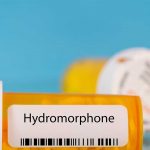- Dilaudid Withdrawal Symptoms
- Dilaudid IR Withdrawal Timeline
- Dilaudid ER Withdrawal Timeline
- Managing Dilaudid Withdrawal
Dilaudid withdrawal can last for up to 10 days after the last dose. Extended-release Dilaudid can cause withdrawal symptoms for twice as long, or up to 20 days after the last dose.
Dilaudid withdrawal occurs in patients who have a physical dependence on hydromorphone. When hydromorphone is a subject of drug abuse, the risk of dependency and withdrawal can be higher.
Opioid withdrawal symptoms can cause difficulties when trying to quit. Medical detox and subsequent substance use disorder treatment program can help you manage the withdrawal process and prepare for recovery.
Dilaudid Withdrawal Symptoms
Dilaudid works by binding to opioid receptors in the central nervous system. This action blocks pain signals, reduces chronic pain, and slows down brain activity.
Over time, the body can adapt to the presence of hydromorphone in the body. If use of hydromorphone stops during this stage, the body can enter withdrawal.
Withdrawal symptoms of Dilaudid can include:
- stomach cramping
- opioid cravings
- nausea
- runny nose
- muscle aches
- high blood pressure
- sleeping problems
- sweating
- severe pain
Severe opioid withdrawal symptoms, such as suicidal thoughts, have also been reported.
Immediate-Release Hydromorphone Withdrawal Timeline
Immediate-release forms of Dilaudid can cause withdrawal symptoms 8 hours to 10 days after the last dose. Initial symptoms of withdrawal may be mild and then progress to severe.
Withdrawal symptoms may be more severe if Dilaudid was taken in high doses before stopping. Symptoms may also begin mild, and then progress to severe as withdrawal continues.
Extended-Release Hydromorphone Withdrawal Timeline
Extended-release hydromorphone tablets can cause withdrawal symptoms 12 hours to 20 days after the last dose. Withdrawal symptoms may be similar to those caused by short-acting Dilaudid.
After acute withdrawal symptoms end, patients may enter a period of post-acute withdrawal. During post-acute withdrawal, patients may not experience symptoms for long periods of time before severe symptoms flare up suddenly.
Post-acute withdrawal can last for months after the last dose, and can be caused by short-acting and long-acting Dilaudid.
Managing Dilaudid Withdrawal
Withdrawal symptoms can prevent people from stopping a pattern of Dilaudid abuse. Quitting cold turkey, or all at once, can make side effects more severe and increase the chance of a relapse. Medical detox programs can improve a patient’s outlook for opiate withdrawal.
You may be recommended to stay at an inpatient treatment facility during detox, where you can receive help from behavioral health professionals and addiction specialists.
Detox may include tapering, a gradual decrease of prescription opioid doses to reduce the severity of withdrawal symptoms.
Patients may also be prescribed methadone, Suboxone (buprenorphine and naloxone), or naltrexone as part of a medication-assisted treatment program.
Treatment Options For Dilaudid Addiction
Opioid addiction treatment programs may follow a successful detox. Addiction treatment programs aim to teach patients coping skills and lifestyle habits to decrease the chance of falling back into illicit drug use.
Treatment programs for Dilaudid abuse may include behavioral therapy, continued medication, referrals to support groups, moving into sober living housing, and other healthcare options.
To find out if our outpatient opioid addiction treatment programs work for you or your loved one, please contact Northeast Addictions Treatment Center today.
Sources
Written by
Northeast Addition Editorial Team
©2024 Northeast Addition Center | All Rights Reserved
This page does not provide medical advice.









